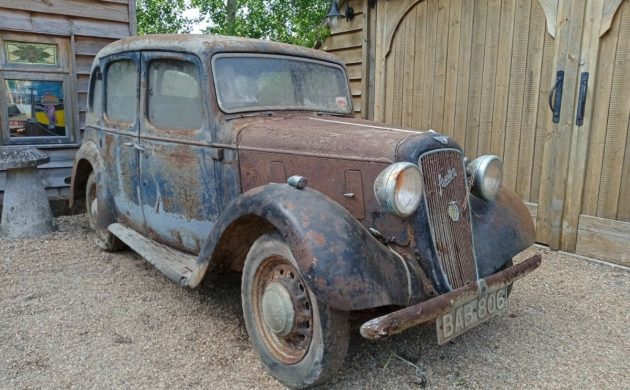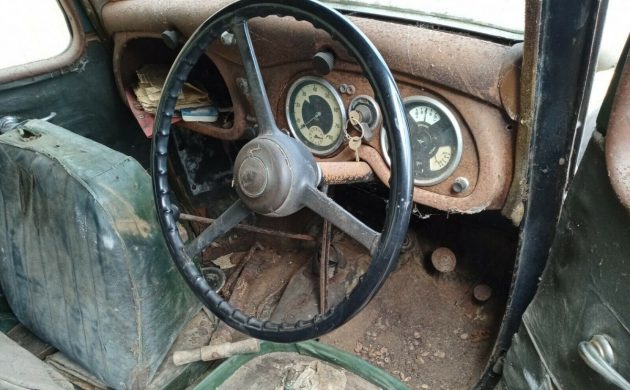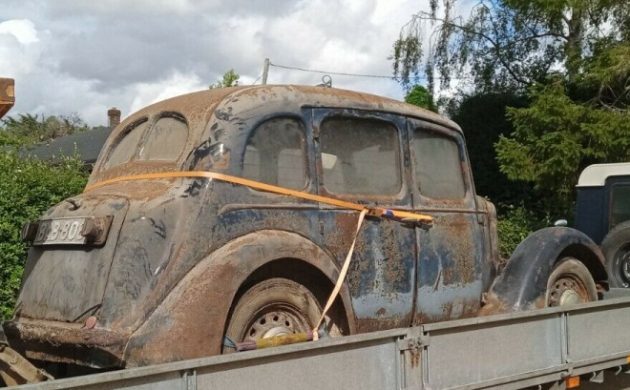Like many, I have a soft spot for BBC dramas, particularly the family-friendly All Creatures Great and Small. It’s nice to have a show that I can watch with the kids that doesn’t involve crime scenes or capes or laser swords, and I was pleasantly surprised at the role played by automobiles in the recent remake. While this Austin 10/4 might be from 1937 and thus a few years after the setting of the current series, it did instantly put me in mind of the Austin 12/4s, Rileys, and Austin 7s that appear in the show. All the more ironic considering that this car is from Upham, a village just outside of Southampton, which is about as far as you can get from Yorkshire and still be in England. The classified ad can be found here on eBay, with a price of £4,250, which comes to about $5,820 American.
The Austin 10 was introduced in 1932 as an intermediate model priced between the Austin 12 and the more downmarket Austin 7. The “10” referred to the fiscal horsepower of the engine, a figure dependent mainly on the number of cylinders and the diameter of the piston surface, and, by 1937, more-or-less unrelated to the actual horsepower produced. This would have been about 26 hp from the 1125 cc flathead inline-4 in 1932, though later examples have claimed in excess of 30 bhp. Rapid evolution of automobile technology in the 30’s meant that the Austin 10 received many upgrades and one complete overhaul, with this 1937 model benefiting from advances like hydraulic suspension elements, an improved clutch, a more streamlined body, and 9-inch diameter drum brakes– now synchronized so that brakes were applied on all four wheels at the same time, regardless of whether the driver resorted to the handbrake or the pedal.
This is an example of the Cambridge saloon rather than the cabriolet, which was known as the Conway. It’s a genuine barn find, put into a shed in 1968 and abandoned until rescued by the current owner. While the seller reports that neither the brakes nor the steering are locked up, there is no word about the engine. Time and degradation aside, there must have been a reason that it originally left the road, and that reason is certainly still there, waiting for the next owner. The interior, as one would expect, is likely a lost cause, but when it comes to the body there doesn’t appear to be much beyond surface rust. But, as the ad says, “viewing is essential before delivery takes place.”
Top speed in the Austin 10 was never a priority for the designers, and 60 mph, while likely technically possible, might be a little ambitious. However, they were designed to be easy to drive, a fact that is reflected in the model’s reputation as a less intense introduction to pre-war British classics. Though I might disagree with the seller about the desirability of long-term storage in a dirt-floored shed, the state of preservation is remarkable– down to the road atlas found in the back seat. Here’s hoping that this car finds the right owner: one with the skills and means to make sure that it keeps on rolling for another 80-plus years.






It’s not usually my style but I’m having trouble not saying this would be a great restomod subject. Well… I guess I did say it.
Looks like it got hit by the war
Was running when parked. BraaaaaaaaaHaaaaaaaaa.
If you read the full ebay description it was. The radiator sprung a leak.
One of my first cars ; bought for a princely 5 pounds in 1964 ( when I was 16 ) from our next door neighbours , I replaced the rings to stop it smoking , taught myself to drive , drove it to the Driving Test Centre when I was 17 , and failed ….got through next time ,though , and had some adventures , as you do .Happy memories of the car and the age .
Do they have yard art in jolly old England? Or would this be the first?
we know how to restore .
What they did have in England when this was made was strong thick good quality steel. I’d wager that all it needs is a decent soda blast and then straight to mud, flatting and paint. And it is complete. I guarantee that if it were mine, I would only need a month or two of evening and weekend work to have this back to its former glory. Most of what is needed is what we call elbow grease.
Seems like a lot of money for this car in this condition. Consider this a British Oldsmobile. What would a ’37 Olds sedan in this shape sell for in the US?
This Austin is about one third of the length of an Oldsmobile and a quarter of the weight.
I meant in terms of its place in the market. The people who bought this car new were likely the same kind of people who bought a new Oldsmobile in the US.
Lovely lines and what I call a “finest hour car” in that it witnessed a lone Britain facing an onslaught the seemingly unstoppable and utterly evil Nazi juggernaut in that critical year between June 1940 and June 1941. Britain stood alone between civilization as we know it and a new dark age until der Fuehrer sent his Wehrmacht in a suicidal plunge into Russia thus dooming him and Germany.. This car was there and saw it all. Imagine the conversations that took place inside it! It should remain in the country of its birth.
A PSA to the older folks on here, do NOT google BBC.
rotflmsao !!!
Why would someone want to drag this junk home to the US there plenty of rusty model Ts here to throw your money away on.
Tim Deal, I feel you answered your own question, yes there are plenty of rusty model Ts in USA, so why would you want another. To me IMO these are a beautiful looking car, when in good condition. I think the seller is VERY optimistic in his price expectations, and you would never get your money back. The history in itself is interesting. These were very good cars for their time, and I doubt many made it to the USA.
Except this is nothing like a model T
I owned a 1934 Austin 10/4 with an 1125cc engine for 28 years, drove the wife and two kids for thousands of miles around South Africa and it NEVER broke down and only had one puncture. At the same time I also had a 1939 Austin Heavy Twelve with a 1535cc engine and believe me, with those anaemic engines and although they were both extremly well built, solid cars, they would be useless on any other American road besides the back roads.
It’s truly a small world.
In the late 1980s I used to visit Hampshire, England, almost every year for the Beaulieu Autojumble and the Dorset Steam Show, and I toured around the area during the week between the 2 events.
I was in the small town of Bishop’s Waltham, visiting the remains of the palace there. I was driving an older car that I then shipped back stateside, when a young man came up and asked me about the car. He said an elderly family member had an old car in a shed, it hadn’t been driven for 50 years or longer (!), and it was only a couple of miles away. So off we went.
It was this very car, in the same basic condition. Turned out it wasn’t for sale anyway, and due to it’s poor condition, this meant I didn’t have to come up with a reason why I wasn’t interested, without letting the poor boy down for his enthusiasm. It was missing the radiator back then, and it probably still is missing the radiator! The only reason it’s still mostly together is the tin roof above it didn’t leak.
What an amazing story ! Thanks for sharing it with us .
I have my last hurahhh in my garage – 1937 Nash Lafayette 400 – just want to make run – no bells or weethles – boy does it look like this one – guess that’s how they built them in the day!
I see the car ho is taking the trailer is a Land Rover Defender. And I like the classic Austin car on the trailer.